Asakichi
kimono (SHIGE Kimono) carries a variety of Kimono and its related
items.
NOTE : These Kimono and Kimono accessories
pictures are representitive of prodcuts sold at ASAKICHI, and are
not photos of actual available products. |
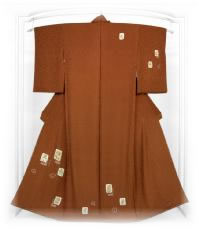 |
Vintage
Kimonos
- women
-men
-Kids |
Discerning customers prefer pre-owned
(vintage) kimonos that are several generations old. In fact, most
of those offered by Asakichi Kimon were created in Japan before
1945. Of course, Asakici carefully
inspects each vintage kimono to ensure only the finest are for sale |
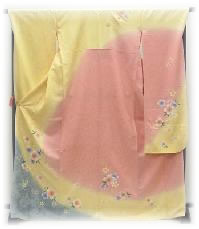 |
Furisode Kimono
makes a very special "statement" in the Japanese societey.
It is only worn by young women who have just reached 20 years
of age. At that point in her life, she is now recognized as an
adult and gains the official right to vote, drink and smoke.
But most significantly,
the young woman wearing the Furisode is obviously declaring her
availability for marriage! The Furisode Kimono is only made from
the highest quality fine silk, with bright colors. |
 |
As you might expect,
the Japanese Wedding Kimono has a long and rich history. Called
an "Uchikake" in Japan, this kimono predates the Edo
period in Japanese history, where, at that time, it was a formal
wear for ladies of noble families and warrior class. Eventually
the Uchikake kimono became a wedding kimono which was passed down
to the brides by each older generation.
Worn as an over-kimono, it is usually adorned with patterns of
pines and chrysanthemums, or birds such as cranes, each created
from very colorful gold and silver threads. The pines and chrysanthemums,
(and frequently, waves) are symbols of long life. Typically there
is a bright red inner lining.Another wedding kimono is the Siromuku,
which translates as "pure white". This pure color symbolizes
that the young bride is a blank canvas ready to learn the new
customs and ways of her husband. |
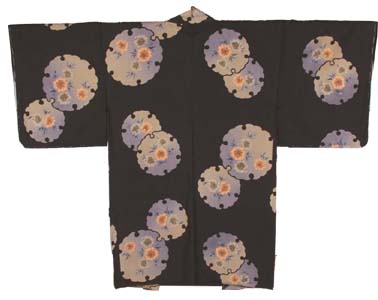 |
The Haori are
half-length jackets that are popular today with both men and women
because they go perfectly with blue jeans, pantsuits, or skirts.
It's designed to be worn partly open making it a "one size
fits all" garmet.Yet for all its fashion sense, the Haori
also has a long history. Prior to the end of Japans's Meiji era,
the Haori was only worn by men. Later though, it became common
for women to wear the Haori over a kimono. |
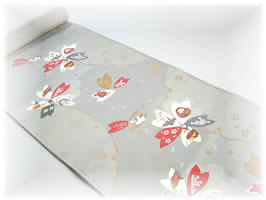 |
When a woman is
properly dressed in the traditional kimono, you immediately notice
the decorative sash tied in a very large bow at the back.This
is called the Obi, and it dates from the Tokugawa period of the
17th to late 19th centruy, where it was originally just a simple
waistband. By the Muromachi period however, the Obi had become
part of the Kimono ensemble and in the Edo period, it reached
today's stature with its wide sash and large bow.
Tying the Obi is quite complex because it is over 12 feet long
and is tied without any hooks or fasteners. Naturally, there are
many types of Obis such as the Hitoe-Obi, Fukuro-Obi, Nagoya-Obi,
Maru-Obi, and so forth, to match the season, occasion,and type
of kimono.Today the Obi is more likely to be found in the home
being used as a display tablecloth or draped over a tansu cabinet.
|
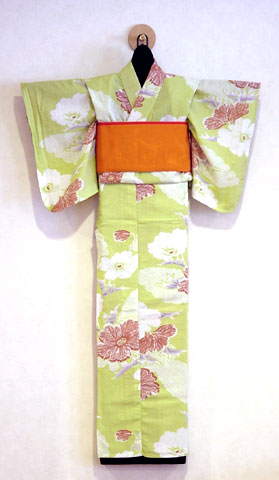 |
If you are looking for a "beginner kimono" the Yukata
is perfect. It's a casual garment made of a light cotton material,
so it does not need the traditional care afforded a typical silk
komono.The Yukata is normally worn in the summer as a bathrobe,
dressing robe, simple streetware, or for some festivals. Stay
at a traditional guesthouse and you will often be expected to
wear a Yukata adorned in their "house color".
The most common colors of
the Yukata are blue and white, but any color or pattern may be
found, making the Yukata you choose a very personal experience.
|
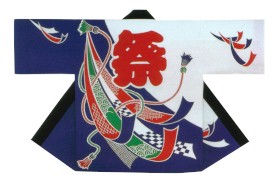 |
The
Happi Kimono is just like it's name sounds...a coat that is worn
at joyous occasions like summer festivals. Also known as a Hanten,
both men and women wear them and adorn them with names and symbols
of festival locations on the front and back. If you are looking
for something very unusual and colorful, look at our Happi Kimonos!
|
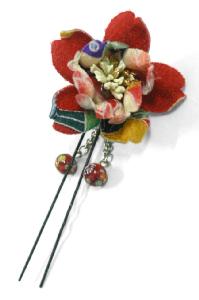 |
No Kimono outfit is complete without the Kanzashi hairpin. Arrange
your hair in a bun hairstyle and then stick in this U-shaped Kanzashi
to hold everything in place. |
Location : 1737 Post Street suite 365, San Francisco, CA 94115
Antique and Art & Tea Ceremony Store
TEL (415) 921-2147
FAX (415) 928-1987
Mon.Tue. 11am - 6pm, Wed. - Sun. 10am - 6pm
|
Copyright ©2007
Asakichi LLC All Rights Reserved. |
|
|









